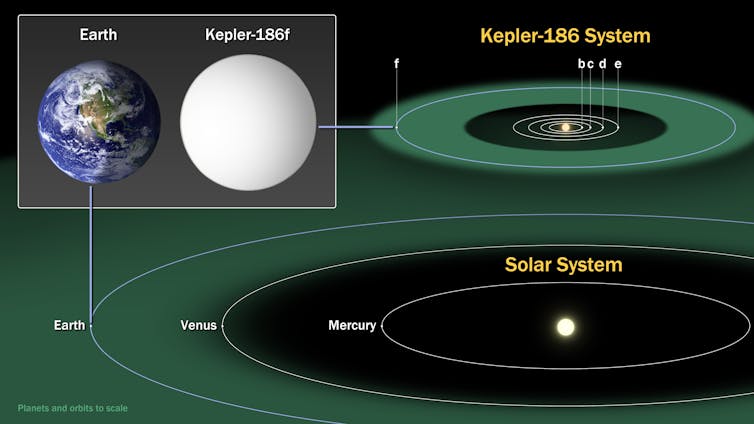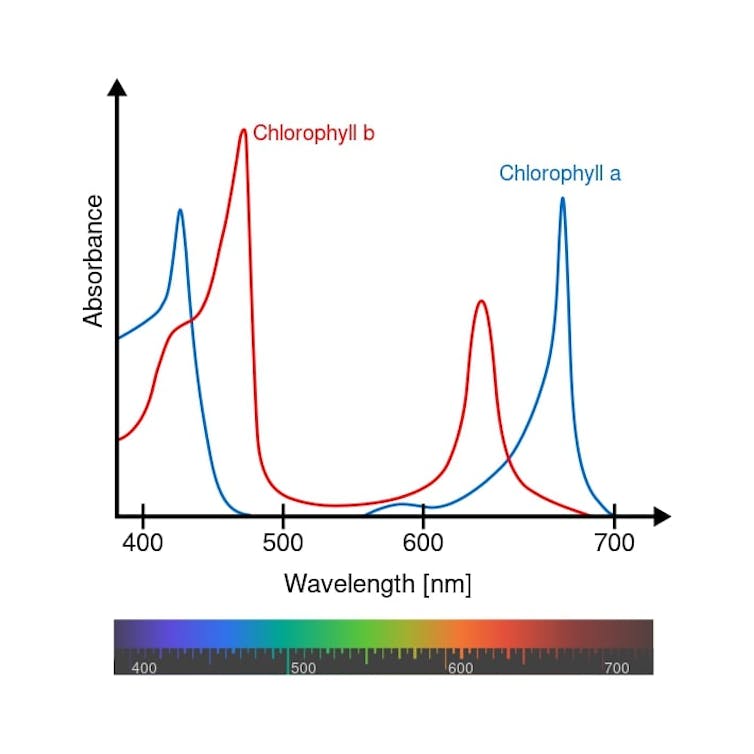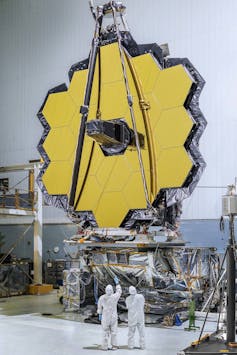
By Chris Impey, University of Arizona, and Daniel Apai, University of Arizona
The ingredients for life are spread throughout the universe. While Earth is the only known place in the universe with life, detecting life beyond Earth is a major goal of modern astronomy and planetary science.
We are two scientists who study exoplanets and astrobiology. Thanks in large part to next-generation telescopes like James Webb, researchers like us will soon be able to measure the chemical makeup of atmospheres of planets around other stars. The hope is that one or more of these planets will have a chemical signature of life.

Habitable exoplanets
Life might exist in the solar system where there is liquid water, such as the subsurface aquifers on Mars or in the oceans of Jupiter’s moon Europa. However, searching for life in these places is incredibly difficult. They are hard to reach and detecting life would require sending a probe to return physical samples.
Many astronomers believe there’s a good chance that life exists on planets orbiting other stars. It’s possible that’s where life will first be found.
Theoretical calculations suggest that there are around 300 million potentially habitable planets in the Milky Way galaxy alone. Calculations also suggest there are several habitable Earth-sized planets within only 30 light-years of Earth. They are essentially humanity’s galactic neighbors. So far, astronomers have discovered over 5,000 exoplanets, including hundreds of potentially habitable ones, using indirect methods that measure how a planet affects its nearby star. These measurements can give astronomers information on the mass and size of an exoplanet, but not much else.

Looking for biosignatures with Webb
To detect life on a distant planet, astrobiologists will study starlight that has interacted with a planet’s surface or atmosphere. If life transformed the atmosphere or surface, the light may carry a clue, called a biosignature.
For the first half of its existence, Earth sported an atmosphere without oxygen, even though it had simple, single-celled life. Earth’s biosignature was very faint during this early era. Then, 2.4 billion years ago, a new family of algae evolved. The algae used a process of photosynthesis that produces free oxygen, which isn’t chemically bonded to any other element. From then on, Earth’s oxygen-filled atmosphere has left a strong and easily detectable biosignature on light.
When light bounces off the surface of a material or passes through a gas, certain wavelengths are more likely to remain trapped in the gas or material’s surface. This selective trapping of wavelengths of light is why objects are different colors. Leaves are green because chlorophyll is particularly good at absorbing light in the red and blue wavelengths. That leaves mostly green light to hit your eyes.
The specific composition of the material the light interacts with determines the pattern of missing light. Because of this, astronomers can learn something about the composition of an exoplanet’s atmosphere or surface by, in essence, measuring the specific color of light that comes from a planet.
Astronomers can recognize the presence of certain atmospheric gases associated with life – such as oxygen or methane – because they leave very specific signatures in light. It could also be used to detect peculiar colors on the surface of a planet. On Earth, for example, the chlorophyll and other pigments plants and algae use for photosynthesis capture specific wavelengths of light. These pigments produce characteristic colors that sensitive infrared cameras can detect. If you were to see this color reflecting off the surface of a distant planet, it would potentially signify the presence of chlorophyll.
Enter the Webb telescope
It takes an incredibly powerful telescope to detect these subtle changes to the light coming from a potentially habitable exoplanet. For now, the only telescope capable of such a feat is the new James Webb Space Telescope. As it began science operations in July 2022, James Webb took a reading of the spectrum of the gas giant exoplanet WASP-96b. The spectrum showed the presence of water and clouds. However, a planet as large and hot as WASP-96b is unlikely to host life.
Yet, this early data shows that James Webb is capable of detecting faint chemical signatures in light coming from exoplanets. In the coming months, Webb is set to turn its mirrors toward TRAPPIST-1e, a potentially habitable Earth-sized planet a mere 39 light-years from Earth.
Webb can look for biosignatures by studying planets as they pass in front of their host stars. It can capture starlight that filters through the planet’s atmosphere. But Webb’s goal was not to search for life. So the telescope is only able to scrutinize a few of the nearest potentially habitable worlds. It also can only detect changes to atmospheric levels of carbon dioxide, methane and water vapor. While certain combinations of these gases may suggest life, Webb is not able to detect the presence of unbonded oxygen, which is the strongest signal for life.

Other telescopes
Leading concepts for future, even more powerful, space telescopes include plans to block the bright light of a planet’s host star to reveal starlight reflected from the planet. This idea is like using your hand to block sunlight to better see something in the distance. Future space telescopes could use small, internal masks or large, external, umbrella-like spacecraft to do this. Once astronomers block the starlight, it becomes much easier to study light bouncing off a planet.
There are also three enormous ground-based telescopes currently under construction that will be able to search for biosignatures. First is the Giant Magellan Telescope, then the Thirty Meter Telescope and lastly, the European Extremely Large Telescope. Each is far more powerful than existing telescopes on Earth. Despite the handicap of Earth’s atmosphere distorting starlight, these telescopes might be able to probe the atmospheres of the closest worlds for oxygen.

Is it biology or geology?
Even using the most powerful telescopes of the coming decades, astrobiologists will only be able to detect strong biosignatures from worlds where life has completely transformed them.
Unfortunately, most gases released by terrestrial life can also have a nonbiological source. Cows and volcanoes both release methane. Photosynthesis produces oxygen, but sunlight does, too, when it splits water molecules into oxygen and hydrogen. There is a good chance astronomers will detect some false positives when looking for distant life. To help rule out false positives, astronomers will need to understand whether the planet’s geologic or atmospheric processes could mimic a biosignature.
The next generation of exoplanet studies has the potential to pass the bar of the extraordinary evidence needed to prove the existence of life. The first data release from the James Webb Space Telescope gives us a sense of the exciting progress that’s coming soon.![]()
This article is republished from The Conversation under a Creative Commons license. Read the original article.
Bottom line: Astronomers hope to use the James Webb Space Telescope to detect biosignatures – signs of life – in the atmospheres of distant planets.











